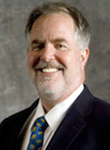Smithsonian's Monfort urges sustaining biodiversity
By Natalie O’Toole

Twenty-five years ago, Smithsonian scientists were handed what was thought to be the last 18 animals of an endangered species. The black-footed ferret, previously thought to be extinct, was rediscovered before being wiped out by plague. The Smithsonian immediately launched a technology-intensive breeding program and can take credit for the 400 ferrets that roam again in their natural habitat.
Steven L. Monfort, director of the Smithsonian Conservation Biology Institute (SCBI), discussed past, present and future projects of his organization in “Smithsonian Conservation: Scientific Approaches for Understanding and Sustaining a Biodiverse Planet” on campus Nov. 6.
In addition to the repopulation of black-footed ferrets, Monfort discussed how the Smithsonian has been studying the behaviors of animals like the clouded leopard, red panda, Asian elephant and cheetah, to prevent them from slipping into extinction.
Finding that cheetah deaths in zoos were quickly overtaking births, Smithsonian researchers discovered that the common practice of pairing two female cheetahs in an enclosure was actually causing one to reproductively suppress the other. After changing the way they promoted breeding, researchers found the animals were successfully mating – seven litters have been reported in the past four years, compared with just two in the previous 120 years.
Monfort believes the Smithsonian is leading the charge in prioritizing conservation. “Bill Conway from the Wildlife Conservation Society once said it’s amazing how zoos will spend tens of millions of dollars to exhibit animals that are about to go extinct but will spend so little to stop them from going extinct in the first place,” Monfort said.
The factors he characterized as the “five horsemen” of the environmental apocalypse – overexploitation, climate change, pollution, habitat loss and invasive species – are destroying Earth’s biodiversity, Monfort said. He believes immediate action must be taken to counteract the devastation humans are causing.
For example, he reported that humans are dumping 100 tons of carbon into the ocean each second. This lowers the water’s pH and negatively affects coral reefs, which help sustain a quarter of all marine life. Smithsonian scientists working at different locations including the Tennenbaum Marine Observatories are leaders in the field of cryo-conservation and are working to propagate various corals to save species from destruction.
Monfort asked, “If species X goes extinct, why should I care?” If one species is eliminated, he said, the balance of an ecosystem is disrupted and biodiversity is lost. “If you value the air that you breathe, the food that you eat, the water that you drink, and the fuel and the fiber that you all need to survive, you should be voting for biodiversity to be sustained,” he said.
Cornell has been partnering with the Smithsonian for a joint graduate training program on endangered species’ fertility in the laboratory of Alex Travis, associate professor of reproductive biology, as well as a long-term study of migratory songbirds with the Cornell Lab of Ornithology. Monfort said the Smithsonian would expand its partnership with Cornell to collaborate on more projects in the future.
“We could use help in things like land use management, agriculture and sustainability, [and] economics for decision-making – the human dimensions of conservation through some of the work that people are doing here. There’s a tremendous amount of cooperation I think could occur in the future, and I hope that it will,” he said.
The lecture was part of the Atkinson Center's “Outside Voices” speaker series.
Natalie O’Toole ’16 is a writer intern for the Cornell Chronicle.
Media Contact
Get Cornell news delivered right to your inbox.
Subscribe